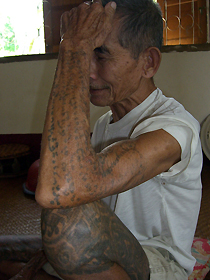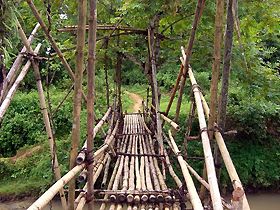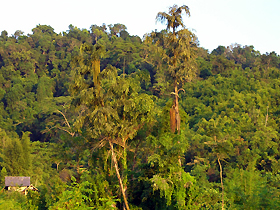(3) NT village, located in Nam Bak district, Luangprapang Province, Lao P.D.R. is mostly comprised of ethnic Lue people, with about 500 households, and is known as a "cultural village" that has preserved its own traditional customs. I conducted intensive research there from September 2004 to December 2005 in order to clarify the process of social change and cultural transformation. I visited NT village again for additional research for 2 weeks from August 30th to September 27th, and covered the three following topics:
1) I investigated the actual situation of social change when the socialist structure was formed after the end of the civil war. After interviewing the village elders, I clarified that the village was thrown into confusion and split due to compulsory conscription and collective production. This crisis was then overcome through the mutual assistance of mainly relationships with blood relatives. As such, the current villagers' attitudes, which lay emphasis on their solidarity and unity, should be understood as an outcome of fear that village order could have collapsed.
2) I surveyed villages that had been separated from NT village. I visited three other villages and researched both the migration process and the present situation. For the most part, those living in these villages still share the same way of thinking as those living in NT village, but at the same time they have a tendency to emphasize their differences. It was a good opportunity for me to reconsider what the "boundary" is between villages regarding relatives beyond the bounds of the administrative unit.
3) I set out to verify a hypothesis about the formation, succession, and division of a "household," or people living together. "Household" indicates the aggregate of people living, producing and consuming, holding festivals and joining in politics together, and is composed of one or more "families". I focused on one household function of holding land, and showed the fluctuations of the members in marriage by means of a household's strategy for securing a working population and property, the effect of political intervention, social change, and personal choice.
These results were obtained by means of a good relationship with the villagers, constructed through a long-term stay and comprehensive understanding of each household. Even if my main interest is the dynamics of society and culture in the local area, I need to utilize an analysis of any other fields for various topics. This is why I could not only approach my research through the village but also through social and cultural fields.
In continuing my research, I will examine the data and conduct further document surveys in order to prepare for presentations at seminars and to contribute to academic journals. I also hope that this work could result in a substantial doctoral thesis.



 21st Century COE Program
-Aiming for COE of Integrated Area Studies-
21st Century COE Program
-Aiming for COE of Integrated Area Studies-